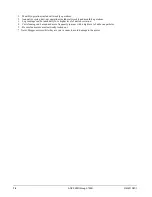
76
AGZ 025D through 190D
OMM 1087-1
certain polymers (e.g. PVC/CPVC and
polycarbonate piping)
Use only the manufacturer’s recommended oil.
Use only new sealed metal containers of oil to
insure quality.
Buy smaller containers to prevent waste and
contamination.
Use only filter driers designed for POE and
check pressure drops frequently.
Test for acid and color at least annually.
Change filter driers if acid or high moisture (>
200 ppm) is indicated (< 100 ppm typical).
Do not use oil additives or refrigerant
additives.
Evacuate to 500 microns and hold test to
insure systems are dry.
The units are factory-charged with lubricant
and one of the following lubricants must be
used if lubricant is to be added to the system:
•
••
Copeland Ultra 22 CC
•
••
Mobil EAL
Arctic 22 CC
•
••
ICI EMKARATE RL RL
32CF
Since POEs are very hygroscopic, they will
quickly absorb moisture if exposed to air.
Pump the lubricant into the unit through a
closed transfer system. Avoid overcharging the
unit.Control and Alarm Settings
The software that controls the operation of the
unit is factory-set for operation with R-410A,
taking into account that the
pressure/temperature relationship differs from
R-22. The software functionality is the same
for either refrigerant.
Refrigerant Charging
The AGZ units have a condenser coil design
with approximately 15% of the coil tubes
located in a subcooler section of the coil to
achieve liquid cooling to within 5
°
F (3
°
C) of
the outdoor air temperature when all condenser
fans are operating.
Once the subcooler is filled, extra charge will
not lower the liquid temperature and does not
help system capacity or efficiency.
If a unit is low on refrigerant, you must first
determine the cause before attempting to
recharge the unit. Locate and repair any
refrigerant leaks. Soap works well to show
bubbles at medium size leaks but electronic
leak detectors are needed to locate small leaks.
Charging or check valves should always be
used on charging hoses to limit refrigerant loss
and prevent frostbite. Ball valve type
recommended.
Charge to 80-85% of normal charge before
starting the compressors.
Charging procedure.
The units are factory-
charged with R-410A. Use the following
procedure if recharging in the field is
necessary:
To prevent fractionalization, liquid must be
charged from the refrigerant cylinder, unless
charging the entire cylinder contents.
The charge can be added at any load condition
between 25 to 100 percent load per circuit, but
at least two fans per refrigerant circuit should
be operating if possible.
Start the system and observe operation.
1.
Trim the charge to the recommended liquid
line sub-cooling (approximately 14-20
degrees F typical).
2.
Verify the suction superheat (10 degrees F
for EEVs and 10 – 12 degrees F for TXVs)
at full load conditions.
Use standard charging procedures (liquid only)
to top off the charge.
Check the sight glass to be sure there is no
refrigerant flashing.
With outdoor temperatures above 60
°
F
(15.6
°
C), all condenser fans should be
operating and the liquid line temperature
should be within 5
°
F to 10
°
F (2.8
°
C to 5.6
°
C)
of the outdoor air temperature. At 25-50%
load, the liquid line temperature should be
within 5
°
F (2.8
°
C) of outdoor air temperature
with all fans on. At 75-100% load the liquid
line temperature should be within 10
°
F (5.6
°
C)
of outdoor air temperature with all fans on.
It may be necessary to add refrigerant through
the compressor suction. Because the
refrigerant leaving the cylinder must be a
liquid, exercise care to avoid damage to the
compressor by using a flow restrictor. A sight
glass can be connected between the charging
hose and the compressor. It can be adjusted to
Summary of Contents for AGZ-D 25
Page 12: ...12 AGZ 025D through 190D OMM 1087 1 Figure 2 Typical Field Control Wiring...
Page 71: ......
Page 81: ......
Page 83: ......









































